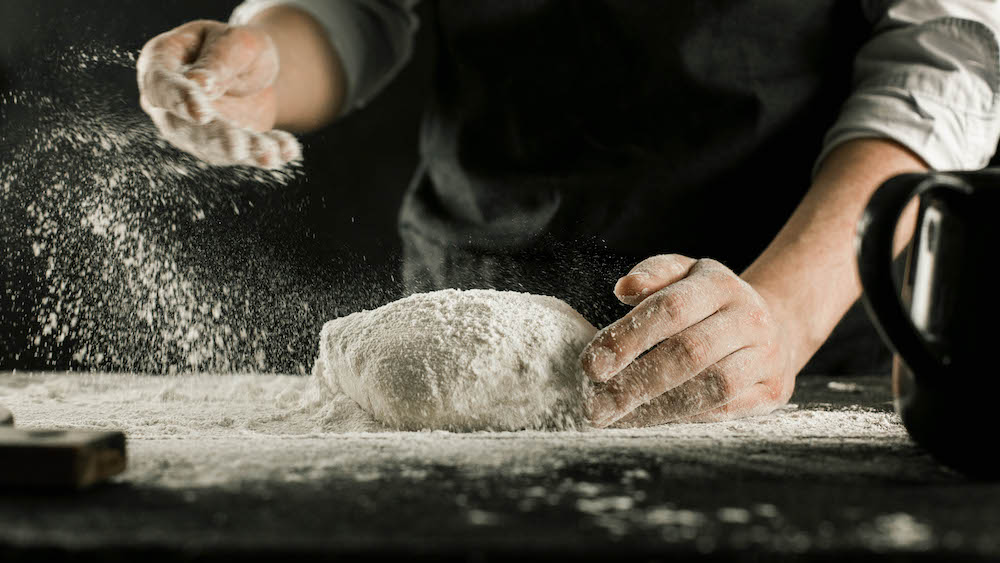The days are getting shorter, and cold fronts are rolling in. If you’re noticing problems with your pizza dough, you’re probably not alone. Maybe it’s not rising properly. Maybe it’s blistering and bubbling. Maybe your pies just won’t bake right or aren’t coming out as crispy as they should. Many of the problems experienced in pizzerias are related to one form or another of temperature control.
At this time of year, the dough prep area or your dough hold/stage area suddenly becomes colder than normal. Additionally, the furnace kicks on and warms the already dry, cold air, further lowering the relatively humidity in the room to a point where it can dry out any dough that is left uncovered in just a matter of a few minutes.
How do you cope with these problems? There is a lot you can do to prevent seasonal issues with your pizza dough. It all begins by controlling the temperature wherever you can. This includes the temperature of the pizzeria itself, your water temperature and your dough temperature.
Related: How to achieve the right dough temperature
First, keep in mind that you’ll always want to establish a targeted mixed-dough temperature (or targeted finished-dough temperature). You should use this temperature year-round to set the stage for dough fermentation. You will also want to measure the temperature of each dough after mixing to make sure you’ve achieved your target temperature range. For most pizzerias, the targeted temperature range will be 75°F to 80°F if you have a walk-in cooler or 70°F to 75°F if you have a reach-in cooler. But the targeted temperature can vary depending on your specific shop conditions, the type of pizzas being made and your dough management procedures. Above all, you want to be consistent.
During a transitional season like fall, you’ll want to control your indoor environment as best you can. For starters, make sure your pizzeria’s thermostat is set in the automatic position, not in the off position. This will prevent you from having to walk into a chilly shop in the morning after a cold front has moved in. You should also make sure your employees keep the doors and windows closed.
Then, there’s the matter of water temperature. In some cities, the tap water temperature is significantly colder during the winter months. If you’re not measuring the temperature of the water that you add to the dough, it’s easy to begin adding colder and colder water without realizing it…until, all of a sudden, a dough problem arises seemingly from nowhere!
Additionally, you have to keep your finished dough temperature in mind. It is crucial to take and record the temperature of each and every dough that you mix in your pizzeria. This will keep you aware of how the seasonal changes are affecting your dough.
Remember: The temperature of your pizza dough is influenced by the conditions in your shop. Colder dough temperatures are telling you that your shop might be getting colder, while warm temperatures obviously tell you that your shop is getting warmer. You can bring your dough temperature back to the right specification by using colder or warmer water in the mix. But you’ll also need to look at the temperature of your staging area after the dough is removed from the cooler and determine how best to address the temperature issue in that area.
For some of us, especially in the northern-tier states, humidity can also become a problem during the winter months. It’s not uncommon to see frigid Canadian air with less than 50% humidity. This in itself is not a problem, but when we heat that air to about 70 degrees Fahrenheit without putting any more humidity into the air, the relative humidity will plummet to less than 25%. Now you’ve got a problem: That’s about as dry as a desert in the summertime. No wonder your dough gets dried out and crusty like an elephant’s skin.
In this case, the only effective course of action is to add moisture to the air. This means the use of a humidifier, whether a free-standing unit or one that’s installed on your heating furnace. Just keep an eye on the humidifier to make sure it’s regularly serviced and operational.
Again, keeping doors and windows closed is imperative to maintaining the right operating temperature in your pizzeria. And while you’re at it, be on the alert for bags of cold flour from that last delivery. It will take a bag of flour about two days to warm up to room temperature if it’s coming in from an unheated storage facility. So it will help if you know what your “normal” temperature is when you open a bag for making dough. Then, you can make an adjustment to the dough water temperature if you’re using a colder-than-usual bag of flour, possibly heading off another one of those days when nothing seems to go right with your dough!
The late Tom “The Dough Doctor” Lehmann was a longtime contributor to PMQ and the former director of bakery assistance for the American Institute of Baking.













